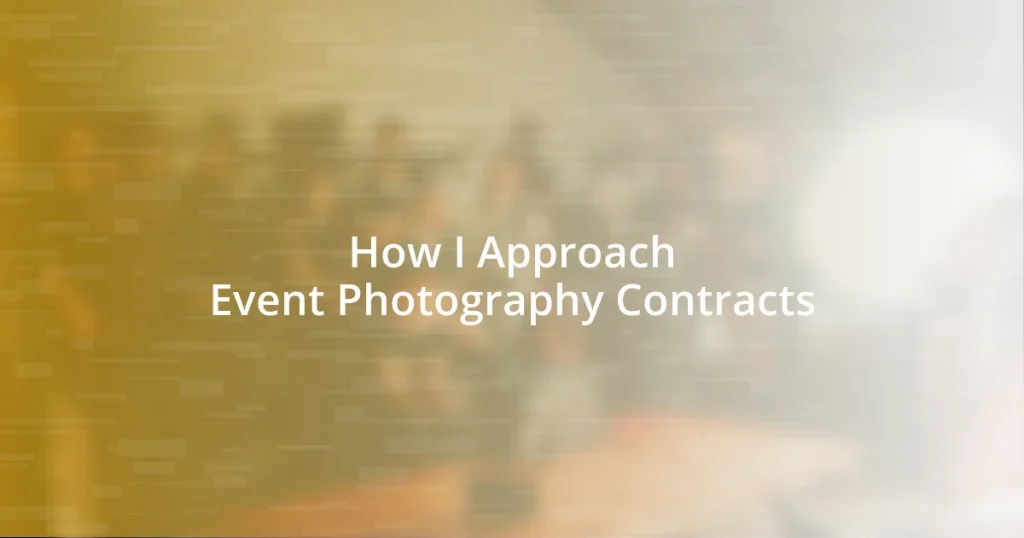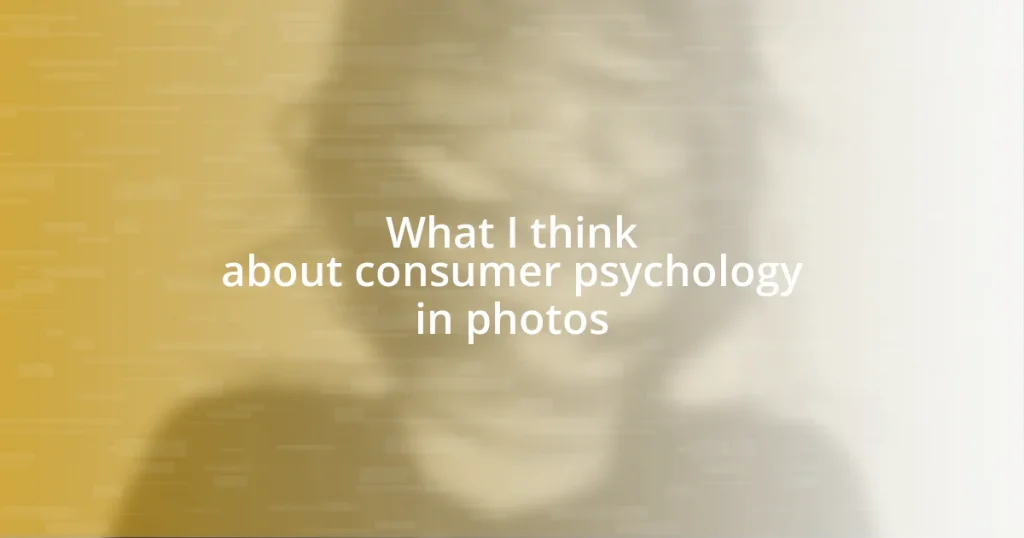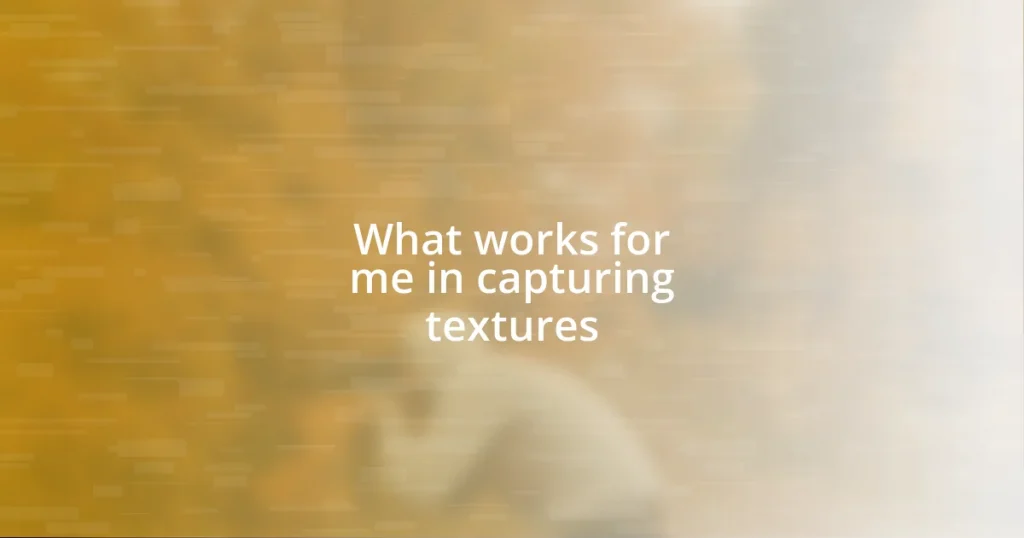Key takeaways:
- Clarity in photography contracts is essential, covering service descriptions, payment terms, and cancellation policies to prevent misunderstandings and foster trust.
- Negotiation should be open and direct, allowing both parties to express priorities, compromise, and establish rapport for a mutually beneficial agreement.
- Legal considerations, such as intellectual property rights and liability clauses, are crucial to protect both the photographer and the client, while clear communication enhances the working relationship.

Understanding Event Photography Contracts
When diving into event photography contracts, I always emphasize the importance of clarity. I remember my first major corporate event; the contract was a maze of jargon that left me feeling uneasy. It’s vital to ensure that both parties understand the terms, including deliverables, payment schedules, and cancellation policies—this clarity can save you a lot of stress down the road.
I often find that reviewing a contract with a fine-tooth comb reveals nuances that impact the entire photographic experience. For instance, I once overlooked an exclusivity clause that prohibited me from shooting for other clients in the same venue. This served as a wake-up call: would I have preferred that restriction, or should I have negotiated it? Each contract is a unique landscape, and I believe asking those questions can help tailor agreements to suit my needs and the client’s expectations.
One key aspect I’ve learned is to trust my instincts about the relationship with clients. If something feels off or overwhelmingly complex, that’s usually a red flag for me. I had a client once who insisted on boilerplate language that didn’t align with my style or approach. In the end, I revised the contract to reflect our mutual vision. Has anyone else experienced that uneasy tug when navigating contracts? It’s essential to balance professionalism with personal touch, ensuring that your unique style is preserved.

Key Elements of a Contract
When I craft a photography contract, I prioritize a clear description of the services to be provided. For instance, I remember a wedding shoot where I detailed not just the hours I would work, but also the specific shots the couple wanted. This clarity not only set their expectations but also gave me a roadmap to follow on a busy day filled with emotions and important moments.
Another key element I focus on is the payment terms. Early in my career, I made the mistake of having vague payment deadlines. I recall a situation where an invoice went unpaid for weeks, only because the client believed it was “flexible.” By defining a precise timeline in my contracts now, I create a professional atmosphere that fosters trust and minimizes awkward follow-ups.
Lastly, cancellation policies are crucial for both parties. I learned this the hard way when I had to reschedule a shoot due to unforeseen circumstances without a solid cancellation clause. I had clients who were understanding, but it was a tough lesson. Now, I ensure that both sides are protected, which ultimately helps maintain a positive relationship throughout the event planning process.
| Key Elements | Description |
|---|---|
| Service Description | Clearly outline the specific services provided to set expectations. |
| Payment Terms | Define precise deadlines to prevent misunderstandings and ensure timely payments. |
| Cancellation Policies | Establish guidelines for cancellations to protect both parties and foster trust. |

How to Negotiate Terms
Negotiating terms can feel daunting, but I’ve found that being open and direct lays the groundwork for a successful agreement. I remember a time when I sat down with a potential client, and we went through the contract line by line. Instead of just accepting the terms, I expressed my viewpoint on the deliverables and timelines, which opened the door to mutually beneficial adjustments. It’s about creating a dialogue where both sides feel heard and valued.
Here are some strategies I’ve adopted to make negotiations smoother:
- Identify Priorities: Before the conversation, make a list of what terms matter most to you, whether that’s payment, turnaround time, or exclusivity.
- Be Ready to Compromise: While you should advocate for your needs, being flexible can lead to a win-win scenario. I’ve had clients offer additional exposure in exchange for a slight adjustment in pricing.
- Establish Rapport: Building a relationship beyond the contract can go a long way. I often share a bit about my creative process or past projects, which can create a connection that influences the negotiation positively.
- Clarify Expectations: Don’t hesitate to ask questions if a term isn’t clear. In one of my negotiations, I learned the importance of confirming every detail—like who holds the rights to the images after the event—before finalizing any agreement.

Defining Scope of Work
When defining the scope of work in my photography contracts, I make sure to specify exactly what services I’ll provide for the event. For example, I once shot a corporate event where the client wanted not just candid shots but also a series of posed group photos. By pinpointing these details in the contract, I provided a clear understanding of what was expected, which ultimately led to a smoother execution of the day.
It’s not just about listing services; it’s also essential to include the timeline for deliverables. I can recall a challenging wedding where I promised to deliver photos within four weeks. When I kept to that timeline, my clients were thrilled, and it strengthened our relationship. Think about it: who wouldn’t appreciate the excitement of seeing their memories captured and delivered promptly?
Additionally, outlining specific equipment and methods can prevent misunderstandings. During an outdoor wedding, I had a couple who specifically requested drone shots. Including that in the contract reassured them that I was prepared to capture their day from every angle. Reflecting on these experiences, I realize that a well-defined scope not only serves as a roadmap for me but also builds a sense of confidence and trust with my clients.

Setting Payment Structures
Setting a payment structure in event photography contracts is crucial for maintaining both professionalism and mutual understanding. I’ve often found that offering a tiered payment system works wonders. For instance, I usually ask for a deposit upfront to secure the date, which not only gives me peace of mind but also shows my clients that I’m committed to their event. I recall one particular wedding where my client was relieved to pay half upfront; it created an immediate trust, allowing us to focus more on the creative details rather than finances.
When it comes to the final payment, clarity is key. I make it a point to specify when the remaining balance is due—typically a week before the event. This strategy minimizes last-minute stress for both of us. In one case, I remember a client who was worried about cash flow but was also eager to secure my services for an anniversary celebration. By establishing a clear payment timeline, we found a middle ground that accommodated their financial situation while ensuring I was compensated for my work, which felt rewarding.
In my experience, additional payment options can also enhance the client relationship. I’ve had clients appreciate the option to pay via credit card, something that adds convenience. Reflecting on these moments, I realize that being flexible with payment structures not only eases the financial burden on clients but also enhances their overall satisfaction, making them feel valued and understood. After all, isn’t that what we all want?

Addressing Cancellations and Refunds
Addressing cancellations and refunds in my photography contracts is essential for managing expectations and protecting both parties. I learned this the hard way during a wedding I was set to cover. Just a few days before the big day, the couple had to cancel due to a family emergency. I was relieved I had included a clear cancellation policy that allowed for some flexibility. It not only eased their minds during a stressful time but also reinforced my professionalism. Have you ever wondered how a simple cancellation clause can foster trust? I truly believe it does.
When refunds come into play, I ensure transparency in my contracts. There was another instance where I had to send a refund due to an unforeseen circumstance on my end. While it felt uncomfortable, I knew that being upfront and fair about the situation made all the difference. I explained to the client the reason for the refund process, and they appreciated my honesty. This experience taught me that clear communication about refunds not only maintains trust but also strengthens my reputation in the industry.
I also find it beneficial to offer partial refunds under certain conditions. During a corporate event, if a client decides to cancel within a specific time frame, I often provide a partial refund. This approach has been met with gratitude from clients; it demonstrates understanding and acknowledges their investment. Think about it—wouldn’t you feel more secure knowing your concerns are being honored in a contract? Balancing flexibility and structure in this way helps me create lasting relationships while ensuring my business remains sustainable.

Legal Considerations in Photography Contracts
Legal considerations in photography contracts go beyond just formalities; they establish the framework for a positive working relationship. One critical aspect I focus on is intellectual property rights. For instance, I always clarify who owns the images after the event. I recall a scenario where a client assumed they had full rights to all the photos, but my contract clearly stated that I retained usage rights for my portfolio. This prevented misunderstandings and ensured I could showcase my work, which ultimately benefits both my business and the client’s access to high-quality imagery.
Another vital element is liability clauses, which can seem daunting but are essential. While shooting a festival, I had to navigate a situation where equipment was damaged due to unforeseen circumstances. Thankfully, my contract included a clause that defined liability limitations. This not only protected me but also reassured my clients that they wouldn’t be held responsible for accidents beyond our control. Have you ever found peace of mind knowing your contract has you covered? I certainly felt relieved knowing I was safeguarded while still focusing on delivering a fantastic experience for the attendees.
Lastly, I always emphasize communication about the legal obligations under the contract. I find it incredibly beneficial to go over these aspects with clients in person, creating an atmosphere of transparency. One time, I held a short session to explain the contract’s important points before a significant event. It was gratifying to see their concerns melt away as they understood their rights and responsibilities. This dialogue not only educated them but also fortified our relationship, making collaboration smoother. After all, navigating legalities doesn’t have to feel like a chore—when handled well, it can actually enrich the client experience.















